
James Gillray on Debt and Taxes during the War against Napoleon
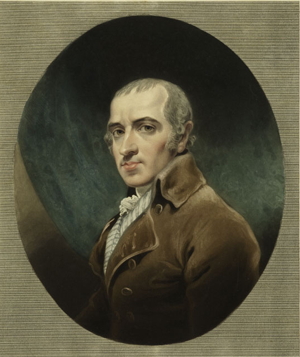 |
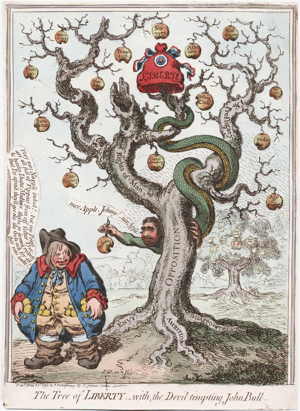 |
| James Gillray (1756-1815) | “The Tree of Liberty with the Devil Tempting John Bull” (1798) |
In this essay we wish to examine 5 prints drawn by James Gillray in the 1790s and 1800s which explore the theme of the suffering of the British people ("John Bull") under the heavy taxation and national debt which the British government imposed on them while fighting the war against Napoleon. Gillray shows us not only the suffering of the British taxpayer but also the groups within the British political and military establishment which benefited from these taxes at Joghn Bull's expence. The caricatures are:
- "BEGGING no ROBBERY; i.e. Voluntary Contribution; or John Bull escaping a Forced Loan" (1796)
- "'The FRIEND of the PEOPLE', and his Petty-New-Tax-Gatherer, paying John Bull a visit" (1806)
- "More PIGS than TEATS, or the new Litter of hungry Grunters sucking John Bull's old Sow to death" (1806)
- "A Great Stream from a Petty-Fountain; or John Bull swamped in the Flood of new-Taxes; Cormorants Fishing the Stream" (1806)
- "Broad-Bottom Drones storming the Hive, Wasps, Hornets & Bumble Bees joining the Attack" (1808)
Useful information about the historical background to the caricatures, especially the identification of the people depicted, can be found in Thomas Wright and R.H. Evans, Historical and Descriptive Account of the Caricatures of James Gillray, comprising a Political and Humorous History of the Latter Part of the Reign of George the Third (London: Henry G. Bohn, 1851).
Historical Context: Taxes, Government Debt, and the Gold Standard 1793-1816
The British government raised its revenue throughout the 18th century by means of a number of sources: a land tax (4 shillings in the pound), excise taxes on items of common consumption. customs duties on imported items (in 1759 the rate was 25%), and loans which were added to the public debt (debt stood at 238 million pounds in 1783 after the War of American Independence). When war broke out against France in 1793 the government initially funded its war effort by taking out more loans - 90% of its expenditures between 1793 and 1798 were from loans, thus doubling its level of indebtedness by the end of that period. Not only did it finance its own war effort but it gave very large contributions to the other monarchies of Europe in order to encourage them to keep fighting the French republicans and then the Bonapartists. By 1815 when Napoleon was defeated the British government debt stood at 875 million pounds.
As the war continued and became increasingly expensive it began to raise taxes, such as the so-called "assessed taxes" on individual items which were imposed on many luxury goods (houses, carriages, servants, horses, plate). These increased so frequently and were applied to more and more items (increasingly on common consumer goods) that it was said of the government that "Wherever you see an object, tax it!" A turning point came in 1799 when an income tax was introduced by William Pitt the Younger; on incomes less than 60 pounds it was zero, over 60 pounds it was 2 pence in the pound, but it rose to 10% for incomes over 200 pounds. By the end of the war the British government was raising 80% of its revenue from the new income and land taxes. The income tax was abolished by Henry Addington in 1802 during a temproary peace with Napoleon, and then reintroduced in 1803 when hostilities resumed. It was finally abolished in 1816 after Napoleon's defeat at Waterloo in 1815. Robert Peel reintroduced the income tax yet again, as a "temporary" measure in 1842 at 7 pence in the pound for incomes over 150 pounds. It has remained in place in various forms ever since.
A second turning point in war funding occurred in 1797 when the British government suspended specie payments. Up until that time Britain had been on the gold standard and claims against the Bank of England could be met by withdrawing gold coins or bullion. By stopping specie payment the government was able to get additional loans from the Bank of England via issuing more paper money. The resumption of specie payment took place some years after the war had ended (May 1821). The crisis in British banking over the suspension of specie payment resulted in the so-called Bullion Controversy. The House of Commons requested a report on the way in which increasing paper note issue led to a rise in the price of gold (bullion), which led to the preparation of the Bullion Report of 1810 written largely by Francis Horner, William Huskisson, and Henry Thornton. It was in response to this report that David Ricardo wrote a number of papers on the issue of bullion during 1809-1811.
Interestingly, the finances of Revolutionary France were quite different. The the negative experience of the heavy endebtedness of the Ancien Régime and the failures of the assignat paper currency in the early years of the Republic meant that France was afraid of unfunded debt and so remained on the gold standard throughout the period. It relied less on borrowing and inflating the money supply as its British counterpart did but it was able to make up the shortfall through its draconion policy of taxing the peoples it conquered (or by the outright confiscation of property). Government debt was also alleviated by a deliberate policy of repudiating the debts held by emigre aristocrats.
About the Artist: James Gillray (1756-1815)

Gillray trained as an engraver but became best known for making hundreds of caricatures of British social and political life in the 1790s and 1800s. He satirized in particular King George III, William Pitt, the French Jacobins, Napoleon, and many others in the British political and military establishment. A recurring theme in his work was the dramatic increase in taxation and the national debt which was imposed in order to fight the wars against Napoleon and which placed a growing burden on the English people (represented as "John Bull"). Gillray also satirized the large numbers of well-connected people in the government and the military who profited from increased government expenditure by depicting them as greedy cormorants, sucking pigs, highway men, and wasps and hornets. These individuals came from both sides of the political spectrum (from the both the Whig and the Tory parites) and were thus called members of the "Broad Bottom'd" (or bipartisan) party.
1. "BEGGING no ROBBERY; i.e. Voluntary Contribution; or John Bull escaping a Forced Loan" (1796)
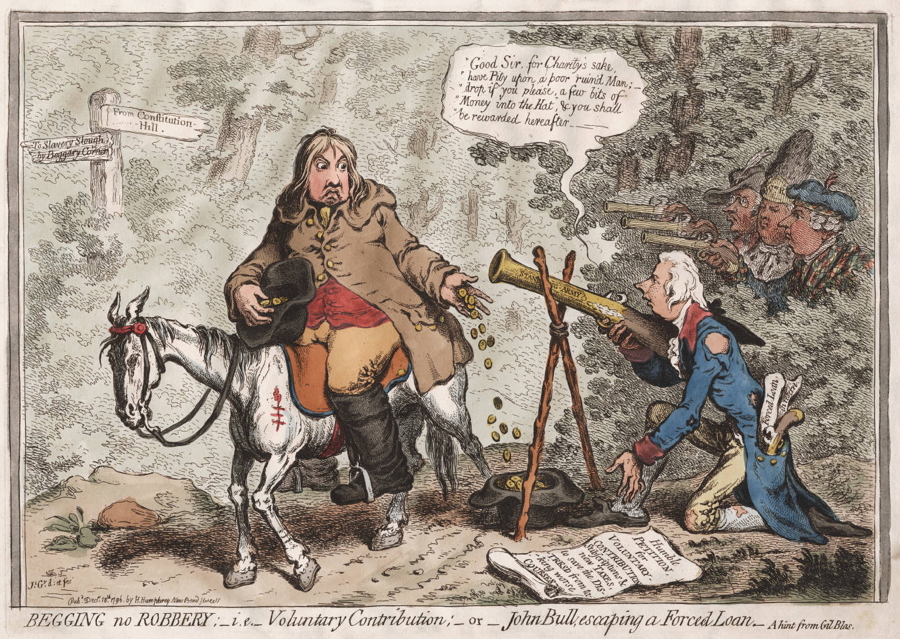 |
"BEGGING no ROBBERY; i.e. Voluntary
Contribution; or John Bull escaping a Forced Loan" (1796) |
Source
Lewis Walpole Library Digital Collection, Yale University Library <http://digitalcollections.library.yale.edu/>
Description
This is one of several caricatures Gillray did about the "voluntary loan" which was a thinly veiled threat by the government that a "forced loan" would be imposed on taxpayers to raise money for the war effort if they did not make "voluntary" contributions to the exchequer. The government created war hysteria of a French invasion or of domestic revolution in order to frighten members of the public ("John Bull") into making contributions to the government. The author and politician Edmund Burke was very active in contributing to this hysteria with his writings in 1795 on "Letters on a Regicide Peace" (1795) in which he described the French Revolution and its supporters as a "cancer" which had to be cut out of the body politic. Wright and Evans [p. 89] believe that Burke is one of the "three banditti" in the bushes to the right (Dundas, Grenville, and Burke) and that the scene is a parody of the picaresque novel Histoire de Gil Blas de Santillane (1715) in which Gil Blas, the son of a poor stablehand and chambermaid, encounters robbers on his way to the University of Salamanca, is forced to assist them, and therefore runs afoul of the law.
Here we see John Bull riding an emaciated horse which looks like it is on its last legs. He has come from "Constitution Hill" and is on his way to "Slavery Slough ("swamp") via Beggary Corner". He has been waylaid by highwaymen hiding in the bushes as he rides by and is obliged to make a "donation" of coins into their hat instead of being forced to make a loan to the government to fund the army. Note the pained expression on his face. The men in the bushes on the right have pistols pointed at him and are wearing fine robes and hats which suggest that they represent the aristocracy, the church, and the law. The man kneeling by the roadside is a soldier wearing torn and bedraggled clothes. He has in his pocket a pistol and a sheet of paper which says "forced loan in reserve". He is holding a blunderbuss on which is written "standing army". In the speech bubble above him it says "Good Sir, for Charity's sake, have Pity upon a poor ruin'd Man; drop if you please, a few bits of Money into the Hat, & you shall be rewarded hereafter." At his feet is a petition which states "Humble PETITION for VOLUNTARY CONTRIBUTIONS, Subscriptions & new TAXES, to save the DISTRESSED from taking worse COURSES."
2. "'The FRIEND of the PEOPLE', and his Petty-New-Tax-Gatherer, paying John Bull a visit" (1806)
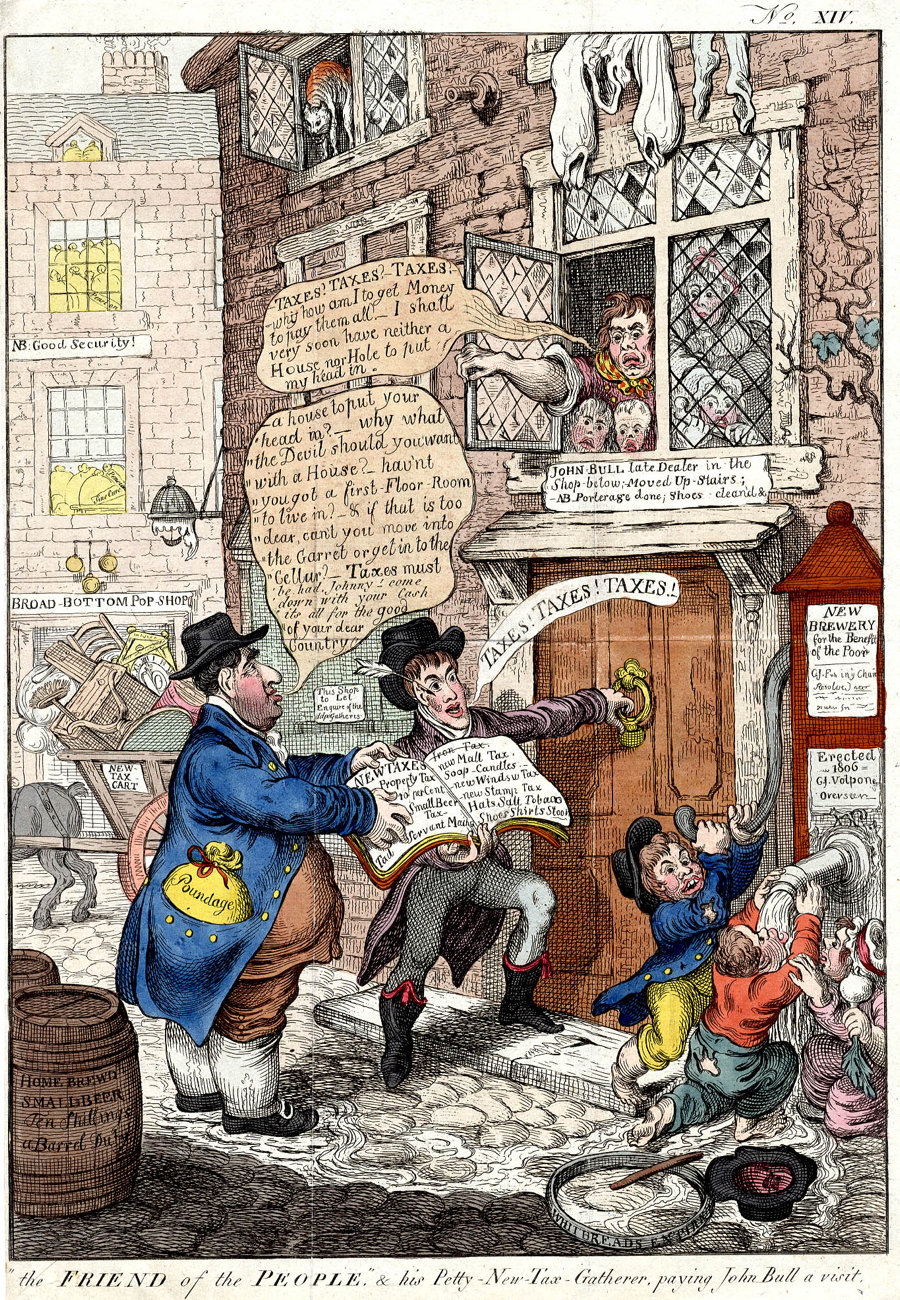 |
"'The FRIEND of the PEOPLE', and his
Petty-New-Tax-Gatherer, paying John Bull a visit" (May 28, 1806) |
Source
Lewis Walpole Library Digital Collection, Yale University Library <http://digitalcollections.library.yale.edu/>
Description
Gillray has ironically called the new tax gatherers in this caricature "The Friend of the People" when obviously from the drawing John Bull and his family are in dire financial straits. A thin looking cat stands in an upper window of their house, washing hangs from a window, his wife and family look frightened when the tax gatherers knock on their door demanding payment of the new taxes, one of the children is gnawing on a meatless thigh bone. A withered grape vine grows on the front of the building. The sign above the front door says "John Bull, late Dealer in the Shop below; Moved Up-Stairs; NB. Porterage done; Shoes clean'd &" . John Bull has lost the lease to his shop (a sign outside says "This Shop to Let. Enquire of the Tax-Gatherer") and has had to move upstairs and do much more menial labour to make a living.
John Bull says to the tax gatherers "TAXES? TAXES? TAXES? why how am I to get Money to pay them all! I shall very soon have neither a House nor Hole to put my head in." Two sharply dressed tax gathers (one with a quill pen behind his ear in order to write down in his ledger the taxes owed and paid - possibly Lord Henry Petty the Chancellor of the Exchequer) are knocking on the door announcing that they have come to collect the new "TAXES! TAXES! TAXES!" They are holding a book which lists all the new taxes the Bulls must pay: property tax 10%, small beer tax, taxes on servants and maids, iron tax, malt tax, window tax, stamp tax, taxes on hats, salt, tobacco, shoes, shirts, and stools. The portly tax gatherer (possibly Charles James Fox) has a large sack of money in his pocket labelled "poundage" (a percentage of a worker's wages taken by the government) and says to John Bull "a house to put your head in? why what the devil would you want with a House? hav'nt you got a first-Floor Room to live in? & if that is too dear, can't you move into the garret or get in to the Cellar? Taxes must be had. Johnny - come down with your Cash, its all for the good of your dear Country."
Wrght and Evans [p. 274] quote from Hansard's Debates, May 15th, 1806 a speech by Fox which parallels what the portly tax gather (Fox) says to John Bull: "According to the extent of a man's income, in many different situations, he might have it in his power to make such alterations in his expenditures as that the tax might not entirely crush him; he might be able in some measure to relieve himself; if he lived in the first floor, for instance, he might remove to the second, and so lessen his expenses: if he was on the second floor already, he might mount to the attic story: but where a man was already to be found in the cellar, where could he be sent to, what reseources could he have?" As Wright and Evans duly note, this caricature was a "most just and happy satire" on Fox's speech in Parliament concerning the new 10% property tax and the hardship which it would impose on the British people.
To the left of John Bull's house is a pawn shop (the "Broad Bottom Pop Shop" with its pawn broker balls hanging above the door - "Broad Bottom" refers to a coalition of politicians from both parties who essentially agree on pursuing a common policy which in this case was increased taxation to fight the war against Napoleon). In the upper story windows we can see large bags of money which suggests that business has been very good as people like John Bull pawn their possessions in order to pay the new taxes. Behind the portly tax gatherer is a horse-drawn cart called the "New Tax Cart" which is filled with household possessions like clocks and furniture which the tax gatherers have possibly accepted in lieu of payment in cash.
In the foreground are numerous references to the new taxes on alcohol. The new taxes on the ingredients for home beer making (malt and hops) meant that working men and women were forced to frequent local pubs which did not have to pay the new taxes (a barrel behind the portly tax gatherer has "Home Brewd Smallbeer. Ten Shillings a Barrel Duty" written on it). Three street urchins (note the girl eating an onion which was a common part of the diet of the very poor) are playing with what looks to be a "beer pump" which is now the only way the poor can afford to drink. The pump has written on the top "NEW BREWERY for the Benefit of the Poor. Erected 1806. C.J. Volpone Overseer". [Volpone, or "the Big Fox", was a character in a play of the same name by Ben Jonson (1606). Volpone was a notorious aristocrat who dupes and tricks others]. At their feet is a drip tray with the name of the manufacturer on it "Whitbreads Entire".
3. "More PIGS than TEATS, or the new Litter of hungry Grunters sucking John Bull's old Sow to death" (1806)
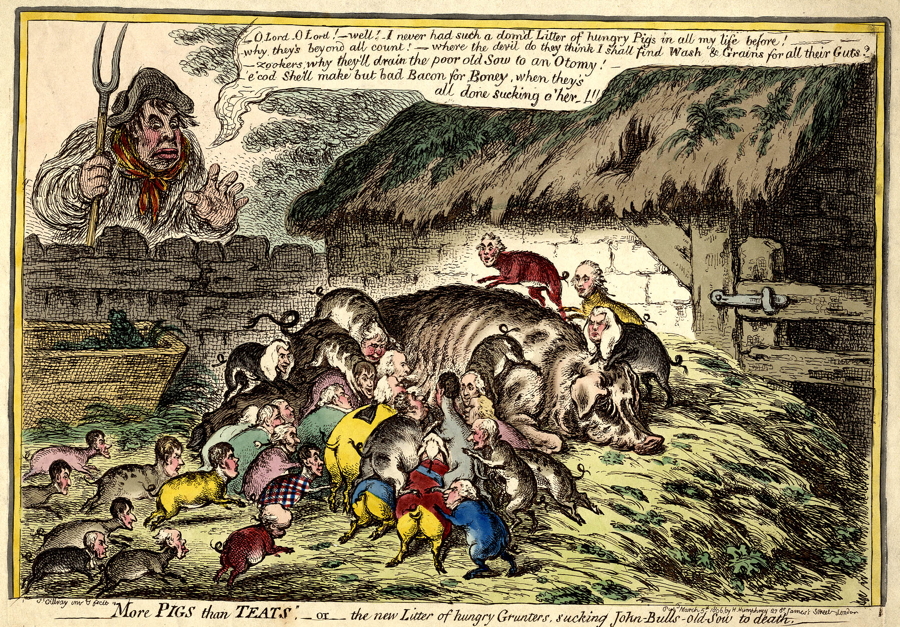 |
"More PIGS than TEATS, or the new
Litter of hungry Grunters sucking John Bull's old Sow to death" (March
5, 1806) |
Source
Lewis Walpole Library Digital Collection, Yale University Library <http://digitalcollections.library.yale.edu/>
Description
In this caricature John Bull is shown as a pig farmer who has come to check on his old sow in the pig stye. The sow represents the British economy which was being sucked dry by all the demands being placed upon it by the British government in order to fight the war against Napoleon, especially the new war taxes. Those doing the "sucking" are the vested interests which benefited from the policy of war, such as members of the government, the law, the military, and the aristocracy. John Bull is shocked to see his poor emaciated sow (emaciated and near death, with a very forlorn look on her face) being besieged by "hungry Grunters" wanting to suck at her teats. John Bull says "O Lord. O Lord! I never had such a dam'd Litter of hungry pigs in all my life before! why they's beyond all count! [I count 28 (editor)]. where the devil do they think I shall find Wash & Grains for all their Guts? zookers, why they'll drain the poor old Sow to an Otomy! (?) e'cod She'll make but bad Bacon for Boney [the English nickname for Napoleon Bonaparte], when they's all done sucking o'her!!!"
Note that some of the human heads on the sucking pigs are wearing the wigs of barristers and judges (one at each end of the sow). Wright and Evans list the following names from the Whig government which had just come to power and who would now be sucking at John Bull's sow's teats: Horne Tooke, Sir F. Burdett, Tierney, Duke of Bedford, Lord Carlisle, Lord Erskine, Lord Grenville, Lord H. Petty, Lord Temple, Lord Derby, Lord Sidmouth, Sheridan, Fox, Grey, Lord Moira, Windham, The Speaker. [pp. 260-61, no. 311].
4. "A Great Stream from a Petty-Fountain; or John Bull swamped in the Flood of new-Taxes; Cormorants Fishing the Stream" (1806)
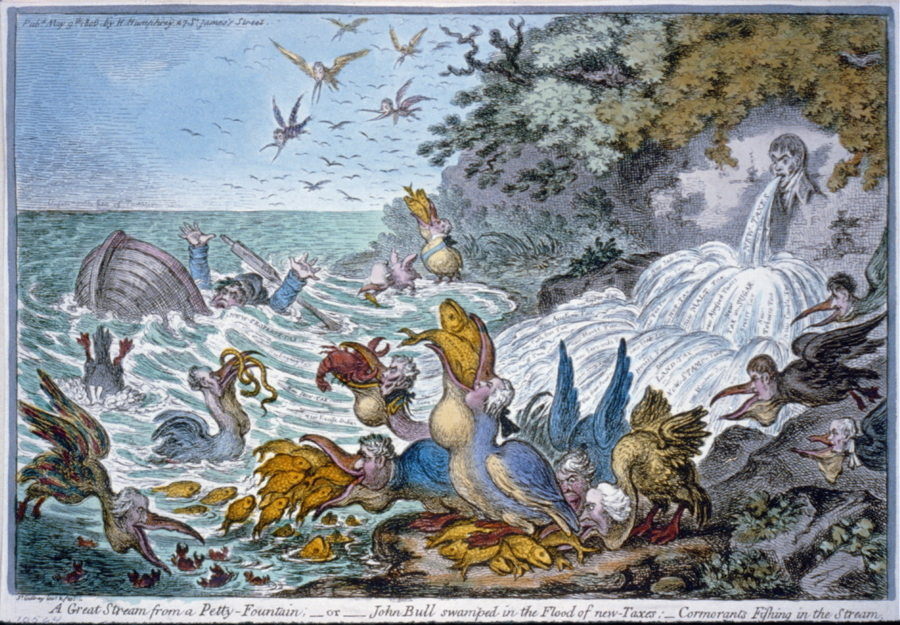 |
"A Great Stream from a Petty-Fountain; or
John Bull swamped in the Flood of new-Taxes; Cormorants Fishing the
Stream" (May 9, 1806) |
Source
Lewis Walpole Library Digital Collection, Yale University Library <http://digitalcollections.library.yale.edu/>
Description
In this caricature, on the left we see John Bull (the personification of Britain) in a sinking boat which has been swamped by a mass of new taxes to fund the war against Napoleon. He has lost hold of an oar with the name of "William Pitt" written on it. [William Pitt the Younger was Prime Minister from 1804-1806 as well as Chancellor of the Exchequer (or minister of finance)]. On the right we see a man's head (probably Lord Henry Petty the new Chancellor of the Exchequer) from whose mouth pours a fountain of water labeled "new taxes" which are named in the cascades of the fountain (taxes on salt, tea, hops, malt, sugar, alcohol, candles, horses, servants, soap, houses, land, stamps, windows, property, etc.). In the foreground we see 10 hungry cormorants with human heads devouring the fish, crabs, and eels which thrive in the waters of the tax fountain. In the middle ground there are 2 other human-headed birds; in the distance we can see dozens more hungry cormorants heading towards the tax feast. The heads of the cormorants probably depict prominent politicians and other figures of the day.
Wright and Evans observe that the Whig party when it was in opposition had opposed heavey taxation but as soon as they were able to form a government they not only retained all the taxes of the old government but introduced a large number of new ones. The Whig's new budget was brought down by the Chancellor of the Exchequer, Lord Henry Petty, whose face can be seen on the right disgorging a stream of new taxes. The cormorants depict the hungry new Whig politicians who eagerly snap up the tax revenues which flow their way. Their heads are those of Windham, Grey, Lord Derby, Duke of Bedford, Fox, Lord Moira, Lord Grenville, Sherdian, Lord Sidmouth, Tierney, Lord H. Petty, Sir F. Burdett, Horne Tooke. [pp. 261-62, no. 313].
5. "Broad-Bottom Drones storming the Hive, Wasps, Hornets & Bumble Bees joining the Attack" (1808)
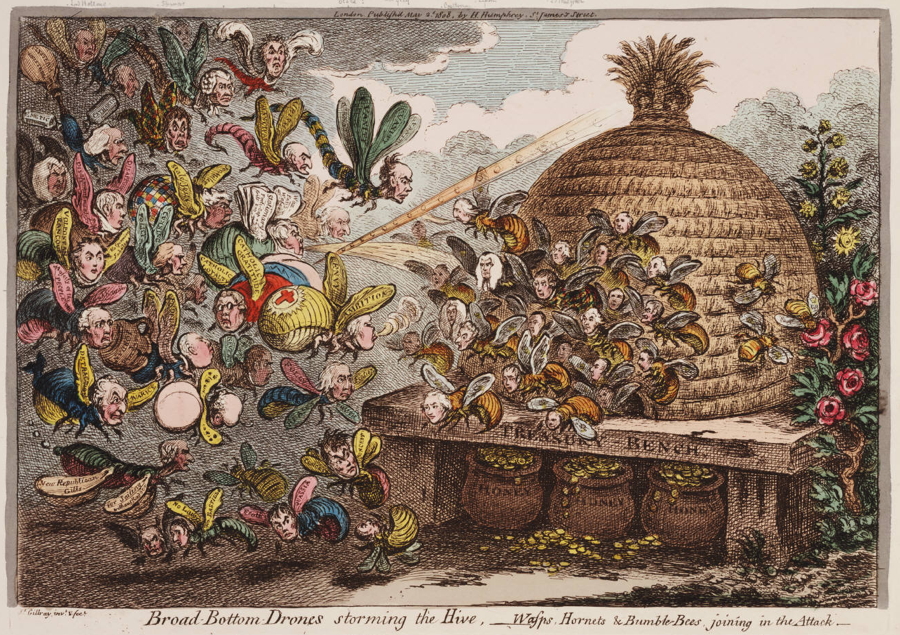 |
"Broad-Bottom Drones storming the
Hive, Wasps, Hornets & Bumble Bees joining the Attack" (May 2, 1808) |
Source
Lewis Walpole Library Digital Collection, Yale University Library <http://digitalcollections.library.yale.edu/>
Description
The expression "Broad-Bottom" in the title refers to a coalition of politicians from both parties (Whig and Tory) who essentially agree on pursuing a common policy which in this case was increased taxation to fight the war against Napoleon. Hence, the attack on the Treasury was a bi-partisan movement by all the vested interests and power groups within the establishment to make use of the increased government revuenue made possible by higher and more numerous taxes imposed upon the British people.
On the right is a beehive which represents the British treasury. The monarch's crown sits on the top and the hive rests on a wooden table on which is written "Treasury Bench". Beneath this are three pots named "Honey" which are brimming over with coins showing the prosperity and wealth of Britain. To the right of the hive we see three productive honey bees collecting nectar in what looks to be the flowers of a rose bush.
In front of the hive are 21 bees who have come forward to protect the hive from marauding wasps, hornets, and bumble bees who have come to steal the hive's honey. These insects perhaps represent all the vested interest groups seeking money and other benefits from the government, or those groups which cost the Treasury money (say for defence). The bees appear to have beaten off one attack - the six insects at the lower left who have turned tail and are retreating. On their wings are written slogans which reveal their affiliation. Most are illegible but one has a pair of wings on which is written "No Laws" and "No Bastille", another has "Incest", suggesting that the British Treasury has been able to defeat the worst of the French Revolution. The face of the bee leading the defense has well defined human features and is probably meant to be Spencer Perceval who was Chancellor of the Exchequer from 1807-1809 and who was able to maintain the war against Napoleon without raising taxes and by cutting costs.
Above the small group of retreating insects (6) is a much more numerous swarm (24) which is advancing towards the hive. The smaller and less distinct insects have the following slogans on their wings: Volponean rancour, vanity, cunning, policy, disappointment, majesty of the people, detractors, profundity, folly, reason - the meanings of which are unclear. At the bottom of the advancing swarm is one long insect with wings which read "New Republican Gills for Sailing without Rudder."
In the middle of the swarm are three large bumble bees who are actively attacking the hive. The top one in green has on his wings Wax" and "Stationary"(a lawyer perhaps) and appears to be vomiting on the hive. The middle one in red and wearing spectacles has on his wings "Catholic Loyalty" and "Catholic Gratitude" and is farting at the crown on the top of the hive (the monarch is head of the established Anglican Church). This may be a reference to the fact that Spencer Perceval continued to oppose Catholic emancipation when he was Prime Minister. The lower bumble bee is yellow with a large red crucifix on its back. His wings say "Envy" and "Ambition" and he is blowing rings of smoke at the hive (suggesting the traditional anti-catholic sentiments of British protestants who thought the Catholic Church wanted to create an independent power structure in Britain that would be loyal to a foreign power, i.e. the Pope, and that it would use the "smoke" of obfuscation and ritual to bamboozle the British people).
Note that in the highest resolution image of this caricature someone has tried to identify in pencil in the margin the names of the individuals whose heads adorn the wasps, hornets, and bumble bees in the picture. Unfortunately these are illegible. However, Wright and Evans [p.316] do provide a list of names which they believe are being caricatured in the print: Lord Sidmouth, Lord Ellensborough, Duke of Bedford, Windham, Lord Carlisle, Lord Spencer, Duke of Norfolk, Lord St. Vincent, Courtney, Lord Lauderdale, Sheridan, Horne Tooke, Duke of Clarence, Lord Erskine, Sir F. Burdett, Lord Moira, Lord Derby, Tierney, Marquis of Buckingham, Lord Temple, Windham, Lord Grenville, Whitbread, Lord H. Petty, Lord Hawkesbury, Lord Eldon, Canning.
British not French Liberty
Although Gillray severely criticed the excesses of the British government during the war against the French Revolution and Napoleon this did not mean that he supported French revoltuionary notion so liberty summarised by the revolutionary slogan of "Liberté, Égalité, et Fraternité" as this drawing from 1798 indicates.
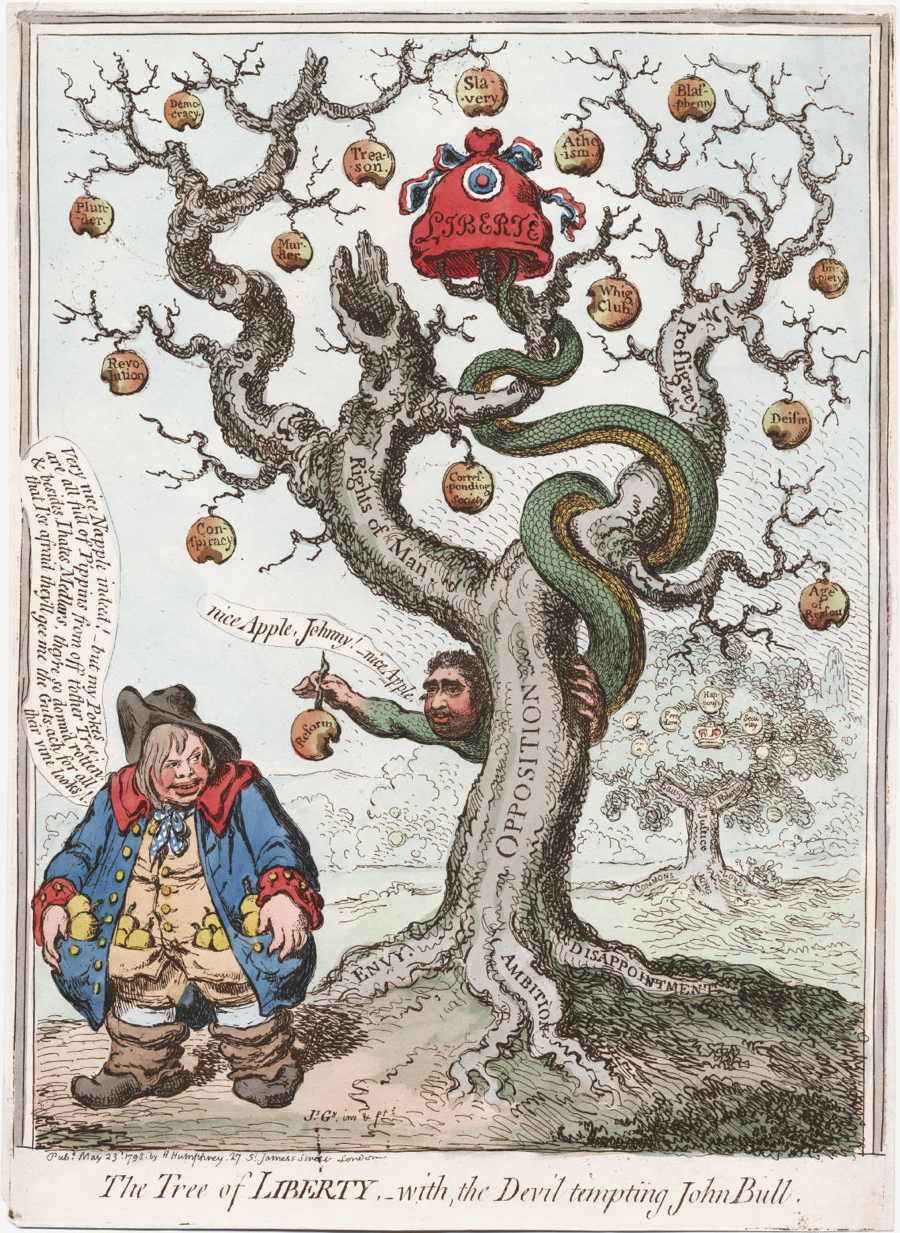 |
“The Tree of Liberty with the Devil Tempting John Bull” (1798) |
Source
From the collection of satitical prints at the British Museum <https://www.britishmuseum.org/collection/object/P_1868-0808-6739>.
Description
Here Gillray contrasts the solid and healthy British oak tree of liberty, with its trunk of "Justice", its roots of "Commons", "King", "Lords", and its branches of "Laws" and "Religion", with the sickly and dying French tree of liberty, adorned with the Phrygian cap of the freed slave, with its trunk of "Opposition", its branches of "Rights of Man" and "Profligacy", and its roots of "Envy", "Ambition," and "Disappointment". The description of the print proviuded by the British Museum is worth quoting in full:
Round a bare and decayed oak-tree is twined a serpent with the head of Fox; he has scaly arms with human hands and holds out a damaged apple inscribed ‘Reform’, saying, “nice Apple, Johnny! - nice Apple”. John Bull (left) is a fat and squat yokel, wearing the Windsor uniform of blue coat with red collar and cuffs. The pockets of his coat and waistcoat bulge with round golden apples. His back is to Fox, towards whom he looks out of the corners of his eyes, saying: “Very nice N’apple indeed! - but my Pokes are all full of Pippins from off t’other Tree: & besides, I hates Medlars, they’re so domn’d rotten! that I’se afraid they’ll gie me the Guts-ach for all their vine looks!” Fox’s scaly tail is coiled round the upper branches; its tip issues from a large cap of ‘Liberté’, decorated with tricolour cockade and ribbons, which is poised on a branch. The trunk of the tree is ‘Opposition’; its roots are: ‘Envy’, ‘Ambition’, ‘Disappointment’. The main branches are ‘Rights of Man’ (see BMSat 7867, &c.) and ‘Profligacy’. Each rotten apple or medlar has an inscription: ‘Democracy.’, ‘Treason.’, ‘Slavery.’, ‘Atheism.’, ‘Blasphemy.’, ‘Plunder.’, ‘Murder.’, ‘Whig Club’, ‘Impiety’, ‘Revolution’, ‘Conspiracy’, ‘Corresponding Society’, ‘Deism’, ‘Age of Reason’ (Paine’s deistic book).
In the background (right) is an oak in full leaf: its trunk is ‘Justice’, the roots ‘Commons’, ‘King’, ‘Lords’, the branches ‘Laws’ and ‘Religion’. From it hangs a crown surrounded by ‘pippins’, some inscribed ‘Freedom’, ‘Happiness’, ‘Security’. (Cf. BMSat 8287, &c.) 23 May 1798.